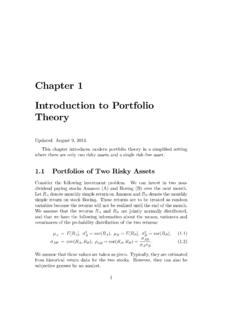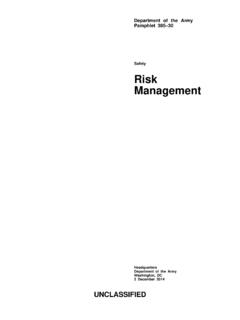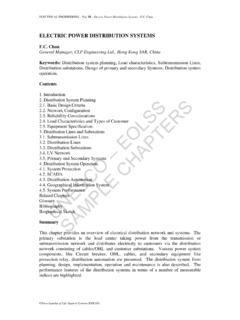Transcription of A survey of loss functions for semantic segmentation - arXiv
1 A survey of loss functions for semantic segmentation Shruti Jadon IEEE Member Abstract Image segmentation has been an active field of have proposed a new log-cosh dice loss function for semantic research as it has a wide range of applications, ranging from segmentation . To showcase its efficiency, we compared the automated disease detection to self driving cars. In the past performance of all loss functions on NBFS Skull-stripping 5 years, various papers came up with different objective loss [ ] 3 Sep 2020. functions used in different cases such as biased data, sparse dataset [1] and shared the outcomes in form of Dice Co- segmentation , etc. In this paper, we have summarized some of the efficient, Sensitivity, and Specificity. The code implementa- well-known loss functions widely used for Image segmentation tion is available at GitHub: and listed out the cases where their usage can help in fast semantic - segmentation - loss - functions .
2 And better convergence of a model. Furthermore, we have also introduced a new log-cosh dice loss function and compared its performance on NBFS skull- segmentation open source data-set with widely used loss functions . We also showcased that certain loss functions perform well across all data-sets and can be taken as a good baseline choice in unknown data distribution scenarios. Index Terms Computer Vision, Image segmentation , Medical Image, loss Function, Optimization, Healthcare, Skull Stripping, Deep Learning I. I NTRODUCTION. Deep learning has revolutionized various industries ranging from software to manufacturing. Medical community has Fig. 1. Sample Brain Lesion segmentation CT Scan [2]. In this segmentation also benefited from deep learning. There have been multiple mask you can see, that number of pixels of white area(targeted lesion) is less than number of black pixels. innovations in disease classification, example, tumor segmen- tation using U-Net and cancer detection using SegNet.
3 Image segmentation is one of the crucial contribution of deep learning TABLE I. community to medical fields. Apart from telling that some T YPES OF S EMANTIC S EGMENTATION L OSS F UNCTIONS [3]. disease exists it also showcases where exactly it exists. It has drastically helped in creating algorithms to detect tumors, Type loss Function distribution -based loss Binary Cross-Entropy lesions etc. in various types of medical scans. Weighted Cross-Entropy Image segmentation can be defined as classification task Balanced Cross-Entropy on pixel level. An image consists of various pixels, and these Focal loss Distance map derived loss penalty term pixels grouped together define different elements in image. A Region-based loss Dice loss method of classifying these pixels into the a elements is called Sensitivity-Specificity loss semantic image segmentation . The choice of loss /objective Tversky loss Focal Tversky loss function is extremely important while designing complex Log-Cosh Dice loss (ours).
4 Image segmentation based deep learning architectures as they Boundary-based loss Hausdorff Distance loss instigate the learning process of algorithm. Therefore, since Shape aware loss Compounded loss Combo loss 2012, researchers have experimented with various domain Exponential Logarithmic loss specific loss function to improve results for their datasets. In this paper we have summarized fifteen such segmentation based loss functions that have been proven to provide state II. L OSS F UNCTIONS. of art results in different domains. These loss function can be categorized into 4 categories: distribution -based, Region- Deep Learning algorithms use stochastic gradient descent based, Boundary-based, and Compounded (Refer I). We have approach to optimize and learn the objective. To learn an also discussed the conditions to determine which objective/ loss objective accurately and faster, we need to ensure that our function might be useful in a scenario.
5 Apart from this, we mathematical representation of objectives, also known as loss 978-1-7281-9468-4/20/$ 2020 IEEE. functions are able to cover even the edge cases. The intro- just positive examples [8], we also weight also the negative duction of loss functions have roots in traditional machine examples. Balanced Cross-Entropy can be defined as follows: learning, where these loss functions were derived on basis of distribution of labels. For example, Binary Cross Entropy LBCE (y, y ) = ( ylog(y )+(1 ) (1 y)log(1 y )) (3). is derived from Bernoulli distribution and Categorical Cross- Here, is defined as 1 y H W. Entropy from Multinoulli distribution . In this paper, we have focused on semantic segmentation instead of Instance Seg- D. Focal loss mentation, therefore the number of classes at pixel level is Focal loss (FL) [9] can also be seen as variation of Binary restricted to 2. Here, we will go over 15 widely used loss Cross-Entropy.
6 It down-weights the contribution of easy functions and understand their use-case scenarios. examples and enables the model to focus more on learning hard examples. It works well for highly imbalanced class scenarios, as shown in fig 1. Lets look at how this focal loss is designed. We will first look at binary cross entropy loss and learn how Focal loss is derived from cross-entropy. (. log(p), if y = 1. CE = (4). log(1 p), otherwise To make convenient notation, Focal loss defines the estimated probability of class as: (. p, if y = 1. pt = (5). 1 p, otherwise Therefore, Now Cross-Entropy can be written as, Fig. 2. Graph of Binary Cross Entropy loss Function. Here, Entropy is defined on Y-axis and Probability of event is on X-axis. CE(p, y) = CE(pt ) = log(pt ) (6). Focal loss proposes to down-weight easy examples and focus A. Binary Cross-Entropy training on hard negatives using a modulating factor, ((1.))))
7 Cross-entropy [4] is defined as a measure of the difference p)t) as shown below: between two probability distributions for a given random variable or set of events. It is widely used for classification F L(pt ) = t (1 pt ) log(pt ) (7). objective, and as segmentation is pixel level classification it Here, > 0 and when = 1 Focal loss works like Cross- works well. Entropy loss function. Similarly, generally range from [0,1], Binary Cross-Entropy is defined as: It can be set by inverse class frequency or treated as a hyper- LBCE (y, y ) = (ylog(y ) + (1 y)log(1 y )) (1) parameter. Here, y is the predicted value by the prediction model. E. Dice loss The Dice coefficient is widely used metric in computer B. Weighted Binary Cross-Entropy vision community to calculate the similarity between two Weighted Binary cross entropy (WCE) [5] is a variant of images. Later in 2016, it has also been adapted as loss function binary cross entropy variant.
8 In this the positive examples get known as Dice loss [10]. weighted by some coefficient. It is widely used in case of 2y p + 1. skewed data [6] as shown in figure 1. Weighted Cross Entropy DL(y, p ) = 1 (8). can be defined as: y + p + 1. Here, 1 is added in numerator and denominator to ensure that LW BCE (y, y ) = ( ylog(y ) + (1 y)log(1 y )) (2) the function is not undefined in edge case scenarios such as Note: value can be used to tune false negatives and false when y = p = 0. positives. ; If you want to reduce the number of false F. Tversky loss negatives then set > 1, similarly to decrease the number of false positives, set < 1. Tversky index (TI) [11] can also be seen as an generalization of Dices coefficient. It adds a weight to FP (false positives). C. Balanced Cross-Entropy and FN (false negatives) with the help of coefficient. Balanced cross entropy (BCE) [7] is similar to Weighted pp.
9 Cross Entropy. The only difference is that in this apart from T I(p, p ) = (9). pp + (1 p)p + (1 )p(1 p ). Here, when = 1/2, It can be solved into regular Dice K. Exponential Logarithmic loss coefficient. Similar to Dice loss , Tversky loss can also be Exponential Logarithmic loss [16] function focuses on less defined as: accurately predicted structures using combined formulation of Dice loss and Cross Entropy loss . Wong et al. [16] proposes 1 + pp to make exponential and logarithmic transforms to both Dice T L(p, p ) = 1 (10). 1 + pp + (1 p)p + (1 )p(1 p ) loss an cross entropy loss so as to incorporate benefits of finer G. Focal Tversky loss decision boundaries and accurate data distribution . It is defined Similar to Focal loss , which focuses on hard example as: by down-weighting easy/common ones. Focal Tversky loss [12] also attempts to learn hard-examples such as with small LExp = wDice LDice + wcross Lcross (19).
10 ROIs(region of interest) with the help of coefficient as shown where below: LDice = E( ln(DC) Dice ) (20). X. FTL = (1 T Ic ) (11). c Lcross = E(wl ( ln(pl )) cross )) (21). here, T I indicates tversky index, and can range from [1,3]. Wong et al. [16] have used cross = Dice for simplicity. H. Sensitivity Specificity loss L. Distance map derived loss penalty term Similar to Dice Coefficient, Sensitivity and Specificity are Distance Maps can be defined as distance (euclidean, ab- widely used metrics to evaluate the segmentation predictions. solute, etc.) between the ground truth and the predicted map. In this loss function, we can tackle class imbalance problem There are two ways to incorporate distance maps, either create using w parameter. The loss [13] is defined as: neural network architecture where there's a reconstruction SSL = w sensitivity + (1 w) specif icity (12) head along with segmentation , or induce it into loss function.
![arXiv:0706.3639v1 [cs.AI] 25 Jun 2007](/cache/preview/4/1/3/9/3/1/4/b/thumb-4139314b93ef86b7b4c2d05ebcc88e46.jpg)

![arXiv:1301.3781v3 [cs.CL] 7 Sep 2013](/cache/preview/4/d/5/0/4/3/4/0/thumb-4d504340120163c0bdf3f4678d8d217f.jpg)
![@google.com arXiv:1609.03499v2 [cs.SD] 19 Sep 2016](/cache/preview/c/3/4/9/4/6/9/b/thumb-c349469b499107d21e221f2ac908f8b2.jpg)









